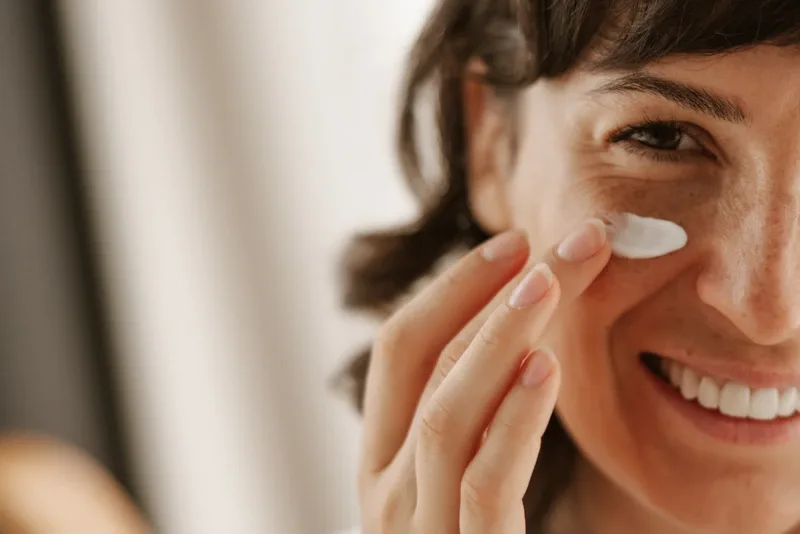Tretinoin is a scientifically-backed, regenerative skincare treatment that helps reduce fine lines and wrinkles, enhance skin renewal, and improve texture and tone. It’s particularly effective to integrate into a skincare routine during menopause.
Tretinoin increases the production of collagen, which is responsible for the strength of the skin’s connective tissues. Within the first five years of the menopause transition, the amount of collagen in a woman’s skin decreases by approximately 30% and continues to drop by 2% annually for the next 20 years.(1) A tretinoin skincare routine can help reduce wrinkles and other age-related skin changes. It also increases epidermal thickness, making the outermost layer of the skin more compact and giving it a smoother appearance.
Treatment options include tretinoin creams, gels, and oral medications. These medications can cause skin irritation and other potential side effects, so it’s important to understand how to safely and effectively integrate tretinoin into a skincare routine.
What is tretinoin?
Tretinoin, or all-trans retinoic acid (ATRA), is a synthetic medication derived from vitamin A. It’s a retinoid and the FDA-approved form of retinoic acid, available by prescription only. The medication has been used to treat various skin conditions and reduce signs of photoaging — including wrinkles, hyperpigmentation, and texture changes — caused by ultraviolet (UV) ray exposure.
Tretinoin works by binding to nuclear hormone receptors in the body that increase collagen production and stimulate the shedding of old skin cells.(2) Retinoids are anti-inflammatory, which means they can also help reduce redness and swelling associated with acne and other skin conditions.
How is tretinoin used?
Tretinoin is prescribed in different forms depending on treatment goals. Topical lotions, creams, or gels are typically recommended for acne or to minimize signs of photoaging, while oral tretinoin may be prescribed for cases of cystic acne. The medication may also be used off-label to treat alternate skin issues, such as psoriasis, warts, or stretch marks.(2)
How does tretinoin work for skincare?
Tretinoin supports skin health in a variety of ways, including the following:
Reducing Breakouts: Corneocytes are a type of skin cell found in the skin’s outermost layer (epidermis). Tretinoin promotes the shedding of these skin cells along with any excess oil and keratin buildup that can clog pores and contribute to the formation of comedones, also known as whiteheads.(2)
Decreasing Inflammation: Tretinoin’s anti-inflammatory properties can minimize symptoms of acne.
Increasing Collagen Production: Tretinoin protects against collagen loss and boosts new collagen production. Some studies have shown that high-strength tretinoin therapy enhances skin elasticity, hydration, and collagen production after several weeks of treatment.(3)
Thickening the Epidermis: Epidermal thickness plays a role in preserving the skin’s moisture as well as protecting the body from infection and injury. Tretinoin treatment may increase epidermal thickness in sun-damaged skin.(3)
Improving Skin Damage: Topical tretinoin treatment may reduce skin damage from UV ray exposure, including fine lines, wrinkles, and hyperpigmentation. The medication promotes the shedding of skin cells containing melanin, which helps minimize the appearance of dark spots, sometimes referred to as liver spots.(3)
Enhancing Results with Combination Acne Treatment: Using tretinoin in combination with certain acne treatments may improve results. One study found that using tretinoin gel alongside the prescription acne medication clindamycin phosphate proved to be more effective than either medication alone.(4) However, the risk of skin irritation increases with the use of multiple medications. It’s best to consult with a doctor before using tretinoin in combination with wart remover, hair removal creams, benzoyl peroxide, or any other medicines.(5)
How long does it take for tretinoin to work?
For acne treatment, it may take two to three weeks of consistent tretinoin use to produce results. In some cases, it may take up to six weeks to see noticeable improvements. Tretinoin treatment for photoaged skin may require three to six months of use to see the effects. Any improvements require continual use for maintenance.(5)

Potential Risks and Side Effects of Tretinoin
Tretinoin takes time to work, and patients may find that acne worsens during the first week of treatment before it gets better. The following are some of the most common side effects associated with topical tretinoin:(2)(5)
Dryness
Skin irritation
Redness
Peeling
Flaking
Burning or stinging sensations
Tretinoin may increase the skin’s sensitivity to the elements, particularly to cold or windy weather. It may also increase sun or UV light sensitivity, making it important to wear sunscreen on a regular basis. The medication should not be used on the eyelids, lips, or nostrils due to the risk of irritation.
Although rare, in the event of severe redness, swelling, peeling, or pain, patients should seek medical attention, as these may be signs of an allergic reaction or potential overdose.(2) Tretinoin can also interact with different medications and supplements. Individuals should speak with their healthcare provider if they take any medications, have skin conditions or allergies, or are pregnant or breastfeeding.
How to Deal with Tretinoin Irritation
The main drawback to using tretinoin is that it can cause irritation and lead to dry, flaky skin that’s prone to stinging and redness. If side effects occur, they will likely develop during the first week or two of treatment as the skin gets used to the medication. Slowly adding tretinoin into a skincare routine can help the skin gradually adjust.
Starting with a lower-strength topical tretinoin can reduce the risk of irritation. The medication comes under different brand names, in different doses, and in either gel or cream form. Dosage strengths can range from 0.025% to 0.05%, 0.08%, and up to 0.1%.(2)(6)
In the event of adverse effects, here are a few strategies commonly recommended for dealing with tretinoin irritation:(5)(7)
Applying the Medication Every Other Day: Tretinoin is intended to be applied to the affected area once at night before going to bed. If irritation occurs, it’s recommended to speak to a doctor about reducing the frequency to once every other day.
Avoiding Too Much Application: Only a thin layer of tretinoin should be applied to the skin. Patients should not exceed the recommended dose prescribed by their healthcare provider. If a dose is missed, the medication should be applied as soon as possible, unless it’s too close to the timing of the next scheduled dose. Doses shouldn’t be doubled, as this can increase the risk of side effects.
Using Mild Skincare and Beauty Products: Using gentle soaps, cleansers, and moisturizers can help reduce irritation as the skin adjusts to retinoid treatment. It’s also recommended to avoid active treatments like acid exfoliants as well as any beauty products containing fragrance, menthol, spices, and other potentially aggravating ingredients.
Tips to Integrate Tretinoin into a Skincare Routine
The key to success with topical retinoids is gradually adjusting the current skincare regimen. The following are a few tips to seamlessly integrate tretinoin into an everyday skincare routine:(5)(7)
Cleansing: It’s important to start by washing the hands and face with warm water and a gentle soap that’s free of harsh chemicals, then gently patting the face dry with a soft towel and waiting 20 to 30 minutes for the skin to fully air-dry.
Avoiding Harsh Products: Using toner or astringent after washing the face is not recommended, as these products can cause excessive dryness.
Moisturizing: Applying a light moisturizer can benefit individuals with sensitive skin. Some doctors may recommend moisturizing as the last step in a tretinoin skincare routine. However, some research shows that using a hydrating, non-comedogenic moisturizer before medication application may prevent skin irritation.(7)
Applying the Recommended Amount of Medication: Less is more when it comes to tretinoin. It should be applied in a thin layer to the skin before bedtime. Using too much may irritate the skin. While mild irritation is not uncommon, it’s crucial to talk to a healthcare provider about applying the medication every other day before working up to nightly doses.
Implementing a Morning Skincare Routine: A morning routine that complements a nighttime regimen can help further maintain skin health. It’s important to choose a gentle facial cleanser and refrain from using abrasive scrubs or loofahs when showering.
Applying Sunscreen: Tretinoin may increase the skin’s sensitivity to UV rays. Daily application of a broad-spectrum SPF 15+ sunscreen can help protect the skin.(2) Wearing sunglasses and a wide-brimmed hat can also help prevent sun damage.
Tretinoin-Based Products for Menopausal Skin Changes
Hormonal shifts during the menopause transition can cause adult acne and changes in skin texture. Because tretinoin helps stimulate collagen production and reduce inflammatory breakouts, skincare products containing tretinoin may benefit women during menopause.
Estriol cream with tretinoin is a topical hormone replacement therapy (HRT) that combines estriol (a form of estrogen) and tretinoin. It can help minimize wrinkles, preserve moisture, and enhance the skin’s tone and texture. Slowly incorporating the cream into a skincare routine once or twice a week may produce improvements over time. A healthcare provider can determine if HRT treatment is a suitable option for addressing menopausal skin changes.
While tretinoin is not a quick fix for skin issues, understanding how the medication works and how to avoid potential side effects can help women steadily rejuvenate the health of their skin.
Factors to Consider with Tretinoin Products
Because tretinoin is a prescription medication, products can’t be purchased over-the-counter (OTC). It’s crucial for women to first speak with a doctor if interested in learning more about tretinoin. Retinoids are not recommended for everyone. Patients must first consult with a healthcare provider and take the following factors into account:
Considerations for different skin types
Dosage strength
Form of medication: gel or cream
Product price
Patient health conditions
Patient medication use
While tretinoin is not a quick fix for skin issues, understanding how the medication works and how to avoid potential side effects can help women steadily rejuvenate their skin health.
